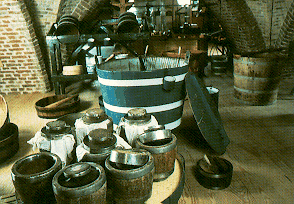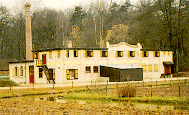
A glimpse into the history of cheese production at the Dutch Cheese Museum.
Open:
April - October, tuesday - friday, 10 - 17 hrs.
Sunday 12 - 17 hrs.
Tel: +31 18252996
 < Dairy factory at the open air museum in Arnhem.
< Dairy factory at the open air museum in Arnhem.
On the 13 th of May 1745, the first stone for a farm-house of the 'cheese-cover' type, where cheese was made, was laid in Zuid-Scharwoude. You can now see this house and its dairy utensils at the open air museum in Arnhem. There is also a Friesian farm-house from Midlum, with a milking cellar, and a churning room for butter making.
The museum's latest addition is the dairy factory Freia, which was in
operation between 1879 and 1970 in the Freisian town of Veenwouden.
The building was brought over stone by stone, and gives, among other things a
picture of cheese and buttermaking in the first industrial phase.
